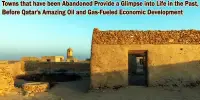Right in the center of the Qatari peninsula, a sizable gap that descends about 100 meters into the earth suddenly yawns open from the rocky desert. Regardless of where you are, at the top or the bottom, it is a stunning sight.
This is Musfur, a huge, ancient cavern that is thought to be Qatar’s deepest accessible sinkhole. It is the largest known sinkhole cave in Qatar that is still open for exploration and is very simple to get to.
Unfortunately, more graffiti has been added to the cave walls recently, which partially ruins the experience. However, it is worthwhile to visit, particularly in the summer when the cave maintains a cool temperature all day.
The location of the facility, just off the main Salwa Road and less than an hour’s drive west of Doha, makes it the perfect choice for those interested in an easy and quick outing.
A barrier protects the Musfur entrance by enclosing it. Although it’s not difficult to get to the sinkhole’s sandy bottom, visitors should use caution as they descend the narrow, rocky tube. You must wear hiking boots, but you must take special care to avoid stepping on the bugs that are creeping between the rocks.
The light from the entrance gradually dwindles as you descend toward the bottom, while a pleasant breeze flows through the limestone and gypsum layers.
While plant life is largely absent, you’ll come across small birds that have built their nests high on rock crevices.
Musfur sinkhole is the deepest of the known and accessible caves in Qatar. Although the visible bottom is just about 100 meters down, some scientists believe a deeper cave network may exist. Once your eyes have gotten used to the darkness after entering the cave through the relatively modest aperture, you will notice a vast chamber rising above and extending below. You can see:
- Layering of different kinds of rock and sediments
- Graffiti on the rocks (not nice, rather scribblings of phone numbers, names, etc.)
- Hundreds of nesting birds
- Traces of small mammals (We saw a small desert fox there once)
Karst creations
Sinkholes are a typical feature of karst topography.
This unique ecosystem results from the interaction of soluble bedrock like limestone with slightly acidic water. The granite eventually weathers and develops openings as a result of the water seeping into it. These voids gradually fill up with soil and sand. A sinkhole is created when they are big enough and the arch opening collapses.
Alongside sinkholes, karst landforms in Qatar include depressions, caves, solution hollows and rawdahs (gardens, meadows or fertile depressions in Arabic).
According to geologists Abdulali M. Sadiq and Sobhi J. Nasir, writing in the Journal of Cave and Karst Studies: “Most karst of central Qatar was formed due to extensive subsurface dissolution of carbonate and sulfate deposits under Middle Pleistocene (325,000-560,000 years ago) wet climatic conditions and consequent subsidence.”
Snapshot of the past
Aspa D. Chatziefthimiou, a senior ecologist and talks coordinator at Qatar Natural History Group, who has visited Musfur several times over the past decade, said descending into the sinkhole opens a window to the very distant past.
“If you know how karst is formed, it’s like you’re going back in geological time; seeing in present time how the water was circulating and creating holes in the bedrock,” she told CNN.
“You’re getting a snapshot and this happens often in Qatar, the trip back through geological time.”
To get to Musfur from Doha involves a drive south on Salwa Road until the exit at Mekaines. From there, it’s off-road so it is recommended to use a map app and an all-terrain vehicle, as the ride on the potholed road is bumpy. A headlamp and water are essential as is, of course, taking any trash home.
















